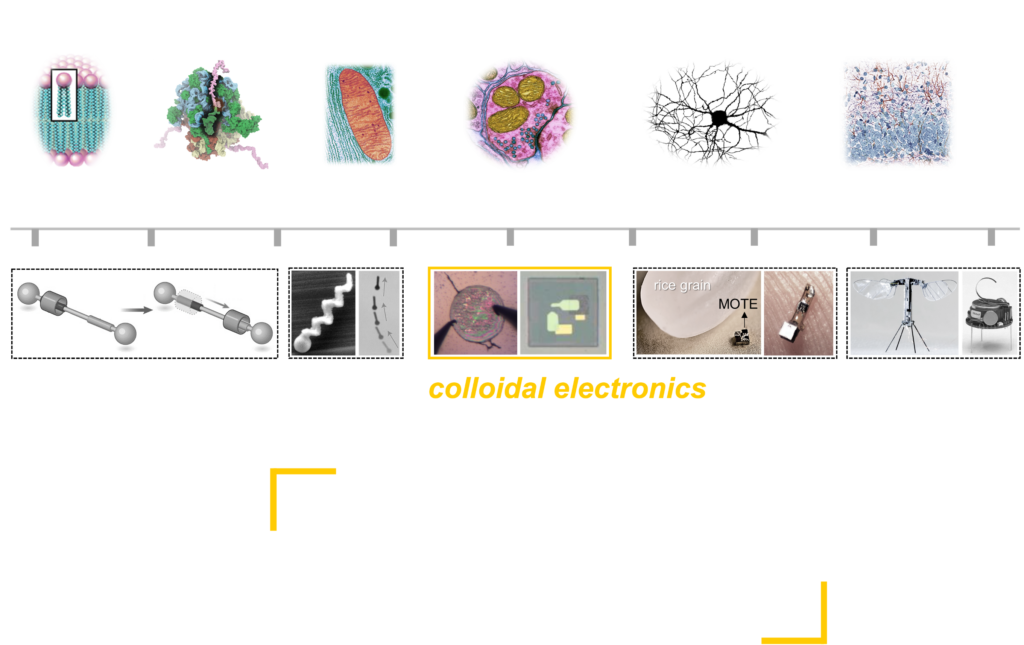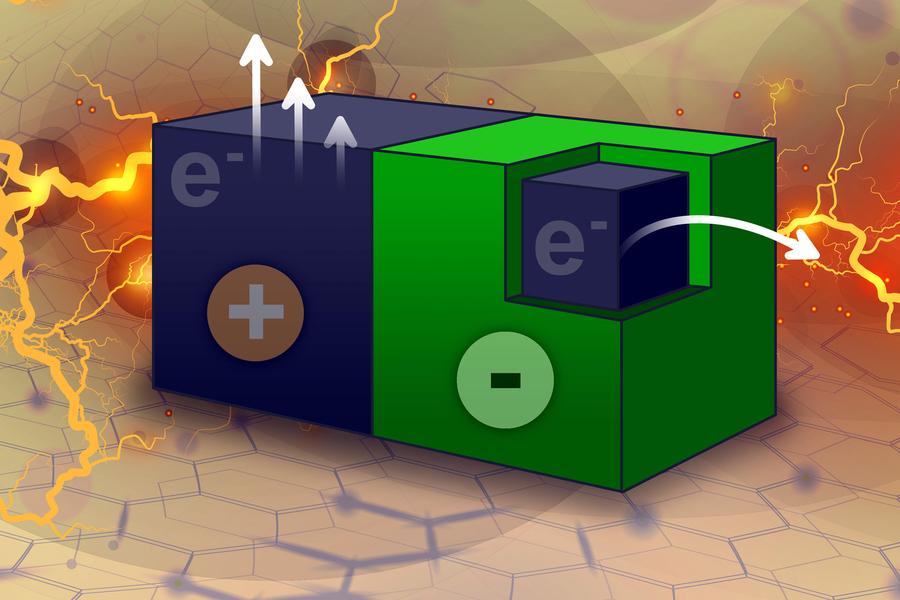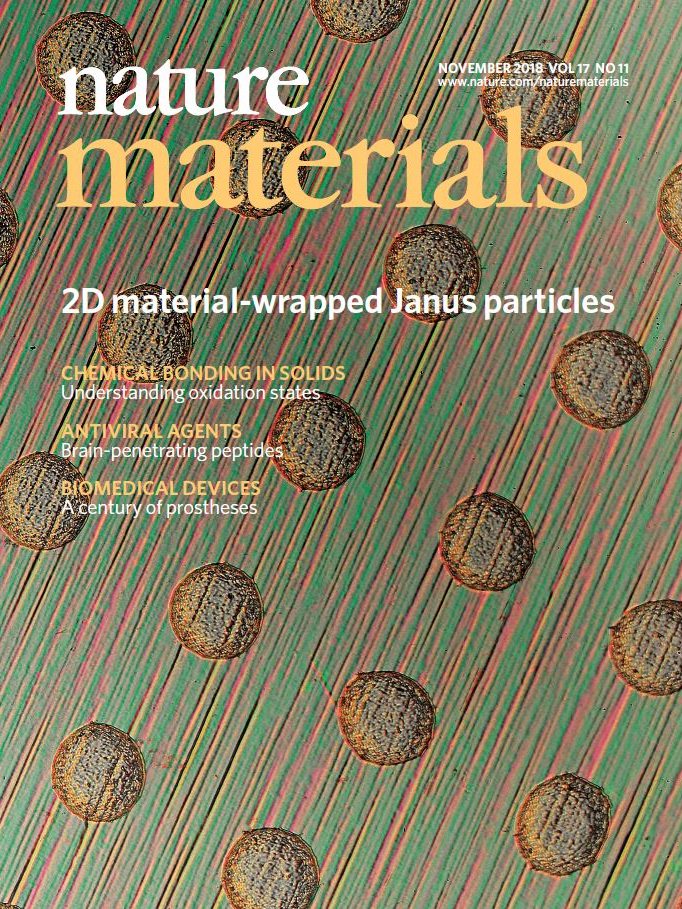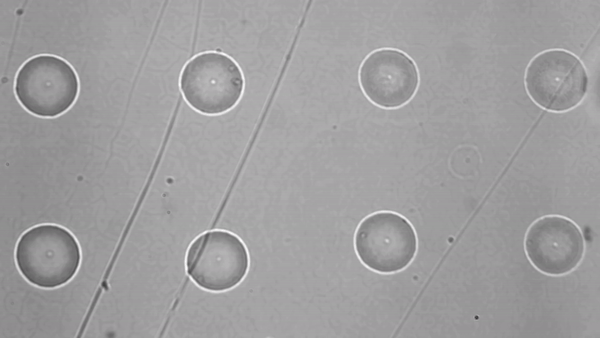
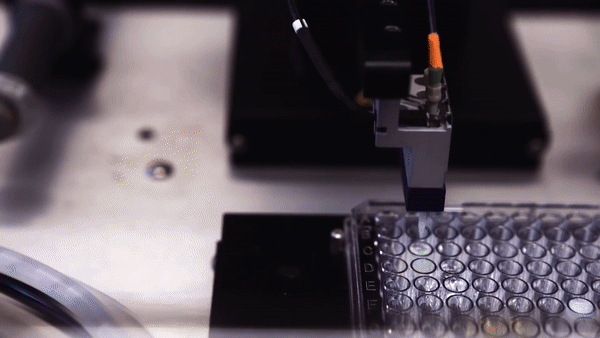
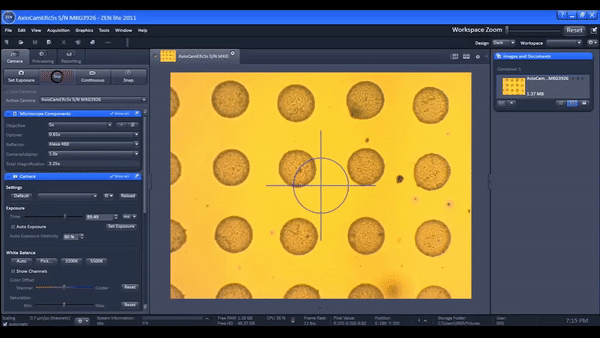

Materials Synthesis
We synthesize and characterize hybrid macromolecular/low-dimensional material composites with unprecedented properties.
Advanced Fabrication
We combine advanced printing methods (e.g., 3-D, ink-jet, and laser-based printing) to assemble emergent robotic systems.
Circuit Design
We bring electricity and electrical circuit design into task-oriented algorithmic matter with embodied intelligence.
Biomedial Engineering
We build in vitro biological platforms that integrate with, and guide the development of, the artificial electronic systems.
What is Colloidal Electronics?
Colloidal electronic ‘cells’, comprised of electronic circuitry connecting artificial ‘organelles’ (e.g., generators, sensors, logic gates, etc.), combine the modularity of modern electronics with the characteristic mobility found in dispersive colloidal systems.
Why Colloidal Electronics?
Minimizing the invasiveness of electronic devices, both in a spatial and a temporal sense, has motivated innovations such as flexible electronics and transient electronics.
Colloidal Electronics – with microscopic sizes that allow them to be dispersed in, and travel with, the surrounding fluid to circulate and exit the body – represent the ultimate flexible and transient electronic system.
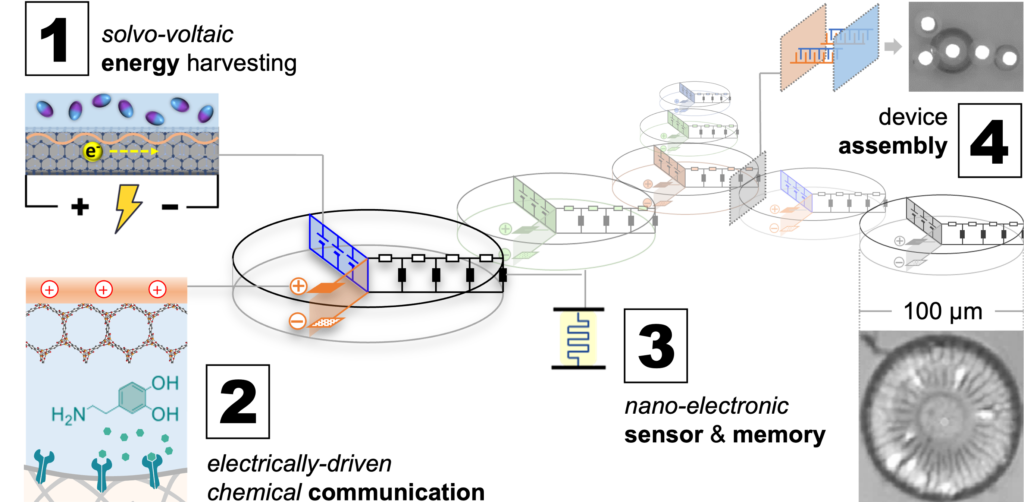
The field of colloidal electronics aims to bring ubiquitous intelligence in the form of distributed systems.
Fundamental to this new platform lie four challenges (outlined blow). Our team at LEGOS engage in four parallel research thrusts aimed at resolving the corresponding challenges.
 Engineering the nano–fluidic interface: energy harvesting for distributed electronic systems
Engineering the nano–fluidic interface: energy harvesting for distributed electronic systems

Electricity is the central energy currency in artificial programmable systems, akin to the role ATP plays in biological systems. Next-generation off-the-grid electronic systems call for alternative modes of energy harvesting. With numerous engineering possibilities in areas like circulating medical diagnostic devices and remote sensors in previously inaccessible locations, the Achilles’ heel for such an electronic system at an extremely small length-scale has by and large been the energy constraint.
While there has been tremendous progress toward improving the energy and power densities for traditional energy storage devices such as microbatteries and supercapacitors, their disadvantageous volumetric scaling poses fundamental constraints on important energy metrics that limit the application space of these electricity-demanding on-board electronics.
To bridge this energy gap, we explore different liquid-based energy harvesting methods more broadly known as the ‘solvo-voltaic’ effect, a phenomenon whereby various local energy inputs are converted into electricity within a quantum-confined nanostructure (e.g., single-walled carbon nanotube, or SWCNT) by virtue of interactions with the surrounding solvent molecules. This technique stands out as a promising candidate to complement existing energy generation schemes like the photovoltaics, whose utility is diminished where visible light is not present, such as in the body.
Featured Publications
(23)
Liu, A. T.; Ge, Z.; Cottrill, A. L.; Strano, M. S.* Direct Energy Generation via Molecular Interaction with Nano-structured Materials, a Mechanistic Perspective. Advanced Energy Materials 2018, 8, 1802212.
(13)
Kunai, Y.†; Liu, A. T.†; Cottrill, A. L.; Koman, V. B.; Strano, M. S.* Observation of the Marcus Inverted Region of Electron Transfer from Asymmetric Chemical Doping of Pristine (n, m) Single-walled Carbon Nanotubes. J. Am. Chem. Soc. 2017, 139, 15328–15336.
(09)
Liu, A. T.†; Kunai, Y.†; Liu, P.; Kaplan, A.; Cottrill, A. L.; Smith-Dell, J. S.; Strano, M. S.* Electrical Energy Gene-ration via Reversible Chemical Doping on Carbon Nanotube Fibers. Advanced Materials 2016, 28, 9752–9757.
(08)
Mahajan, S. G.†; Liu, A. T.†; Cottrill, A. L.; Kunai, Y.; Bender, D.; Castillo, J.; Gibbs, S. L; Strano, M. S.* Sustainable Power Sources Based on High Efficiency Thermopower Wave Devices. Energy and Environmental Science 2016, 9, 1290–1298.
[Related Press] MIT News | Fox News | Gizmodo | Engadget | ZME Science
 Engineering the nano–bio interface: electro-catalysis & nanopore-electroporation for inter-device & device-to-cell communication
Engineering the nano–bio interface: electro-catalysis & nanopore-electroporation for inter-device & device-to-cell communication

Decentralized (unit-to-unit) communication enables neighboring electronic devices to transmit and receive information between one another. On-demand synthesis and release of messenger molecules remains a less explored strategy for enabling inter-unit communication in synthetic systems, despite its prevalence in nature – from the use of hormones for long-distance control of biological processes to the production of neurotransmitters across synaptic clefts for information relays. This modality of signal transmission is particularly effective between microscopic units in confined spaces (e.g., low diameter pipe flow with a large Péclet number).
With the ability to generate electricity locally, our group explores in situ electro-catalytic syntheses of messenger molecules (e.g., small organic molecules, hormones, neurotransmitters) as a means of inter-device communication. This also opens up the exciting possibility for artificial electronic devices to ‘communicate’ with adjacent biological cells – a prospect that could change the current landscape of human-machine interaction, as well as that of precision medicine for local intervention of pathological cellular processes.

Aside from chemically generating signaling molecules to communicate with biological systems, we are also working on physical methods to direct the material communication to and from cells via tuning an externally applied electric field. The efficient introduction of macromolecules, such as DNA and proteins, directly into cells provides a method to manipulate cells and is the crux of multiple biological tools and medical related applications, such as genetic engineering and therapies, cell imaging, and biophysical models.
Recently, the use of a vertically aligned nanoporous membrane was used to localize the electroporation of cells cultured on top of this membrane. Electroporation only occurs at the nanopore-cell junction directly above the membrane, where the externally applied electric field is concentrated and magnified, limiting the disruption of the cell membrane and preserving cell viability. Meanwhile, the macromolecular cargo can be accelerated in a charge-specific manner inside the vertically aligned nanopores, determined by the polarity of the external electric field, and be effectively “injected” into the cells. This bypasses the slow diffusion process in traditional electroporation which greatly enhances the delivery efficiency and specificity of desired macromolecular cargos. The use of these “electric-field-focusing” nanoporous membranes as site-specific nanopore-electroporators opens up the type of format cells can be electroporated in while also minimizing the negative effects of traditional electroporation.
Featured Publications
(30)
Liu, A. T.†; Kunai, Y.†; Cottrill, A. L.; Kaplan, A.; Zhang, G.; Kim, H.; Mollah, R. S.; Eatmon, Y. L.; Strano, M. S.* Solvent-induced Electrochemistry at an Electrically Asymmetric Carbon Janus Particle. Nature Communications 2021, 12, 1–9.
 Engineering the nano–nano interface (internal): low-power nano-electronic circuits and their incorporation into colloidal particles
Engineering the nano–nano interface (internal): low-power nano-electronic circuits and their incorporation into colloidal particles

Arming nano-electronics with mobility extends artificial systems into traditionally inaccessible environments. Our previous efforts have established that carbon nanotubes (1D), graphene (2D) and other crystalline materials with well- defined lattice structures can be incorporated into polymer microparticles, granting them unique electronic functions. The resulting colloidal electronic ‘cells’ (ca. 100 μm in diameter), comprised of microscopic circuits connecting artificial ‘organelles’ (e.g., generators, sensors, logic gates, etc.), combine the modularity of modern electronics with the characteristic mobility found in dispersive colloidal systems. They perform autonomous functions integrating optical energy harvesting, chemical detection and digital memory recording – all within a form-factor no larger than biological cells.
Nano-electronic materials enable low-power circuit elements that are critical for the power management of colloidal electronics. There are many different nano-electronic modules one can incorporate into the colloidal electronic platform. One example of such low-power circuit elements that we work on is the memristor. Hailed as one the four fundamental circuit elements (together with resistors, capacitors and inductors), memristors (or ‘memory-resistors’) are two-terminal electrical resistors that possess two interchangeable memristance states: ON and OFF. We seek to advance the designs for energy efficient memristive channels – aimed to minimize the amount of energy needed for memristors to switch between ON (conductive) and OFF (insulating) states.
Featured Publications
(31)
Yang, J. F.; Liu, A. T.; Berruueta, A. T.; Zhang, G.; Brooks, A. M.; Koman, V. B.; Yang, S.; Gong, X.; Murphey, T. D.; Strano, M. S.* Memristor Circuits for Colloidal Robotics: Temporal Access to Memory, Sensing, and Actuation. Advanced Intelligent Systems 2021, 2100205.
(22)
Liu, P.†; Liu, A. T.†; Kozawa, D.; Dong, J.; Saccone, M.; Koman, V. B.; Wang, S.; Son, Y.; Wong, M. H.; Strano, M. S.* Autoperforation of 2D Materials for Generating Two Terminal Memresistive Janus Particles. Nature Materials 2018, 17, 1005–1012.
[Related Press] MIT News | Nature Materials News & Views | Science Daily | Future Tech Podcast
(19)
Koman, V. B.; Liu, P.; Kozawa, D.; Liu, A. T.; Cottrill, A. L.; Son, Y.; Lebron, J. A.; Strano, M. S.* Colloidal, Nanoelectronic State Machines Based on 2D Materials for Aerosolizable Electronics. Nature Nanotechnology 2018, 13, 819-827.
[Related Press] MIT News | Nature Review Materials | Nature Nanotechnology News & Views
 Engineering the nano–nano interface (external): functional self-assembly of distributed devices into integrated electrical networks
Engineering the nano–nano interface (external): functional self-assembly of distributed devices into integrated electrical networks

Functional self-assembly is the autonomous organization of components into task-oriented systems. The ability to overcome the entropic barrier to form hierarchical structures is an essential process in biology as well as the overarching objective of colloidal robotics. The goal is to develop higher order organizations of colloidal robotic devices with spatial heterogeneity, exhibiting ensemble-level functional utilities that push the limit of traditionally inanimate systems at the microscale. Specifically, we will leverage recent advances in both top-down (e.g., additive 3D printing) and bottom-up (e.g., guided self-assembly) techniques for colloidal robotic device integration in a distributed manner.
Most functional materials today are single-level assemblies of monomeric units. In contrast, biological systems have taken a multi-layered approach (i.e., organelles → cells → tissues, etc.), allowing multiple control checkpoints to be established at different levels. Our on-going efforts include incorporating colloidal robotic devices (which themselves consist of modular components with specialized functions) within existing materials such as fabrics and paint. Colloidal ink mixtures composed of minuscule electronic devices can be extruded into fibers, and subsequently weaved into textiles. When dispersed in solution or a polymer matrix, these electronic colloids can also be directly sprayed onto various surfaces.
Biology is replete with examples of dynamically assembled structures such as flocks of birds or foraging ant colonies. Translating these versatile organizations into inanimate systems requires an understanding of how dissipation of energy can lead to the emergence of ordered structures from disordered components. Because the components in dynamic self-assembling systems interact with one another nonlinearly, their behavior is often complex. As an early example, we fabricated a system of chemo-mechanical relaxation oscillators that exhibit an emergent self-synchronized rhythmic beating at the micro-scale. This complex system-level oscillation emerging from particles sharing a deceptively simple physical design exhibits highly tunable frequency. This simple chemo-mechanical oscillator provides a widely accessible experimental design to probe how rhythmic beating could come about amongst early multi-cell organisms, and illustrate how primitive entities could self-synchronize and exhibit complex collective behaviors.
Featured Publications
(29)
Liu, A. T.†; Yang, J. F.†; LeMar, L. N.; Zhang, G.; Pervan, A.; Murphey, T. D.; Strano, M. S.* Autoperforation of Two-dimensional Materials to Generate Colloidal State Machines Capable of Locomotion. Faraday Discussions 2021, 227, 213–32.
Research Videos
2 min
MIT on Autoperforation
15 min
Applied Energy Conference
30 min
Nano Explorations
45 min
Albert on Colloidal Electronics

